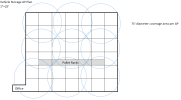HCHTech
Well-Known Member
- Reaction score
- 4,412
- Location
- Pittsburgh, PA - USA
I'm working on a quote to add wifi coverage to a large open steel building. 150' x 175' = 26,250 sq. ft. 23' ceilings throughout - no internal partitions, only steel support pillars.
The will be a line of pallet storage about 1/3 of way down the short side extending most of the way across the space, effectively dividing the space into two smaller spaces: 50' x 175' = 8,750 sq. ft and 100' x 175' = 17,500 sq. ft.
This space will be used for vehicle storage - 2 semi tractors w/trailers, several smaller vehicles, trailers and lots of equipment. All of the vehicles will have onboard software that uses internet to report various monitoring statistics, receive updates, etc. All equipment will be inventoried using a web-based system with QR codes read by a phone app. No desktop computers or offices, only the occasional laptop. Building will not be accessed continually, so lots of security cameras inside and out.
We're a Unifi shop, so I'm thinking either 4 or 6 U6 Enterprise units should be plenty, but I've never had to cover a space this large, so I'm second-guessing that estimate. UI isn't much help, the specs for both the U6 Pro and U6 Enterprise say coverage is 1500 sq. ft. That can't be right, can it? At that rate, I would need 18 APs to cover 26,250 sq. ft... Assuming coverage is a circle, 1500 sq. ft means that circle would have a radius of 40' - that seems way to small to me.
Also, I'm concerned about the home-runs from the far APs will exceed 300' or at least be very close to the limit. If I use four and place them equidistantly, then we're talking about 100' out and 140' across and 20' down to the patch panel = 260' for the farthest one, assuming we can run things in a straight line...
If I use 6 and place them equidistantly, then 116' out and 140' across and 20' down to the patch panel = 276' total for the farthest one, assuming we can run things in a straight line. That's getting a little close to the limit for me. What is the solution here - place a switch in the middle somewhere? Ethernet booster? Since these will be PoE lines, that complicates matters as well.
Hoping for some suggestions from those who have done something similar. TIA!
The will be a line of pallet storage about 1/3 of way down the short side extending most of the way across the space, effectively dividing the space into two smaller spaces: 50' x 175' = 8,750 sq. ft and 100' x 175' = 17,500 sq. ft.
This space will be used for vehicle storage - 2 semi tractors w/trailers, several smaller vehicles, trailers and lots of equipment. All of the vehicles will have onboard software that uses internet to report various monitoring statistics, receive updates, etc. All equipment will be inventoried using a web-based system with QR codes read by a phone app. No desktop computers or offices, only the occasional laptop. Building will not be accessed continually, so lots of security cameras inside and out.
We're a Unifi shop, so I'm thinking either 4 or 6 U6 Enterprise units should be plenty, but I've never had to cover a space this large, so I'm second-guessing that estimate. UI isn't much help, the specs for both the U6 Pro and U6 Enterprise say coverage is 1500 sq. ft. That can't be right, can it? At that rate, I would need 18 APs to cover 26,250 sq. ft... Assuming coverage is a circle, 1500 sq. ft means that circle would have a radius of 40' - that seems way to small to me.
Also, I'm concerned about the home-runs from the far APs will exceed 300' or at least be very close to the limit. If I use four and place them equidistantly, then we're talking about 100' out and 140' across and 20' down to the patch panel = 260' for the farthest one, assuming we can run things in a straight line...
If I use 6 and place them equidistantly, then 116' out and 140' across and 20' down to the patch panel = 276' total for the farthest one, assuming we can run things in a straight line. That's getting a little close to the limit for me. What is the solution here - place a switch in the middle somewhere? Ethernet booster? Since these will be PoE lines, that complicates matters as well.
Hoping for some suggestions from those who have done something similar. TIA!


